More Junkmail from Bob!
Sunday, May 30, 2004Important Stuff.
Maps
I had a picture of the moon in a recent Junkmail. Someone asked me what that planet or star was next to the moon. I had taken the picture several days earlier, and I took it on the east coast. How would I find out important information like this? On the internet, of course. The star just to the right of the moon in this picture is Antares.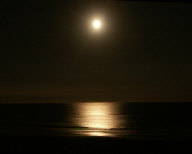
Fourmilab is John Walker's (the AutoCAD guy) web site. He made a pretty good skymap.
http://www.fourmilab.ch/cgi-bin/uncgi/Yourhorizon
Need an U.S. map? http://maps.yahoo.com and http://mapquest.com are pretty good.
Need more detail? This USGS map viewer has selectable layers such as water, roads, boundaries, terraserver, landsat, and USFS maps. It's a lot of fun to play with.
http://nmviewogc.cr.usgs.gov/viewer.htm
If you want to download the data for a large map image or map software, you can do that here:
http://seamless.usgs.gov/
Neutrino Mines
Neutrinos are tiny subatomic particles. But then, all subatomic particles are pretty tiny, aren't they? Neutrinos have very little mass and no electric charge. This means they can fly around and not be affected much by nearby atoms. This, in turn, means that neutrinos can pass through a lot of matter on their way to wherever they're headed.http://education.jlab.org/glossary/neutrino.html
http://www.sciam.com/askexpert_question.cfm?articleID=000C732C-3B0C-1C71-84A9809EC588EF21
How do you catch a neutrino? It's easy. Just watch some water for a while and wait for a flash of light. You can't see the neutrino itself, but you can occasionally see a flash of light when it slams into a hydrogen atom. It's a good idea to use a good-sized tank of water so you'll collect more neutrinos. A million gallons or so should do. You have to make sure it's very pure so the light flashes can be seen.
There are normally a lot of subatomic particles and odd forms of energy flying around, so it's best to eliminate these when you're catching neutrinos. One way is to surround yourself with about a mile of solid rock. That blocks out most of the stray neutrons and etc., while the neutrinos fly through the rock almost as easily as they're flying through your body right now, which happens at a rate of about 10,000,000,000,000 neutrinos per second. Luckily they don't do much damage when they pass through gizzards and other innards.
The light flashes caused by neutrinos hitting water are pretty small. You'll need some very sensitive light sensors. Photomultiplier tubes work pretty well. You'll need a few thousand of them.
http://www.hpk.co.jp/Eng/products/ETD/pmte/pmte.htm
In 1998 some people at Japan's Super-Kamiokande lab discovered that at least some neutrinos have non-zero mass. Before then, nobody knew whether they have mass or not. The Super-Kamiokande lab is in an active zinc mine in the Japan Alps. They've been observing neutrinos, at least indirectly, since 1996.
http://hep.bu.edu/~superk/about.html
Here's the view from the water tank. It's full of water when it's operating.
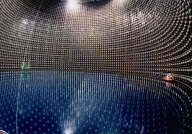
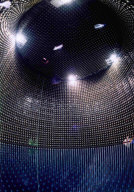
In November 2001 a bunch of the photomultiplier tubes at Super-Kamiokande broke. During or shortly after the filling of the water tank, almost 8,000 of the 11,200 photomultiplier tubes imploded. They think one of them was damaged and imploded under pressure, with the shock wave setting off a chain reaction.
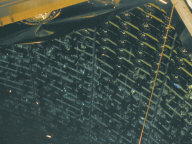
http://articles.findarticles.com/p/articles/mi_m1200/is_21_160/ai_81110071
If you're building a neutrino lab, you might consider using heavy water instead of regular water. Heavy water is H2O just like normal water, but the hydrogen atoms have an extra neutron or two. Heavy water is also handy for making helium, although quite a lot of energy can be released in the process.
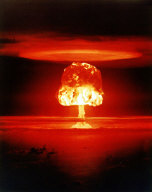
There are three varieties of neutrinos. One of the three (the electron-neutrino) reacts with regular water, but the other two (muon and tau neutrinos) only react with heavy water because of the extra neutron weakly attached to the hydrogen atom.
http://www.physicstoday.org/pt/vol-54/iss-8/p13.html
The Sudbury Neutrino Observatory in Sudbury, Ontario found its first neutrino in 2001. It uses about a quarter-million gallons of heavy water.
http://www.sno.phy.queensu.ca/sno/first_results/
Here's what it looks like:
http://www.sno.phy.queensu.ca/images/man_on_deck.GIF
There's another neutrino lab down south. At the South Pole. This one is a neutrino telescope that detects point sources of neutrinos from space.
http://xpda.com/junkmail/junk157/amanda_brochure-print.pdf
They melt a deep hole in the ice using a hose and hot water, drop a string of sensors down the hole, and then they let it re-freeze. Here are some results of their research:
http://www.amanda.uci.edu/results.html
Here are some really good pictures of the Amanda II Lab and a good tour of South Pole Station.
http://www.amanda.uci.edu/travel/travel.html
A panorama of the Amanda South Pole site:
People have been chasing neutrinos since they were theoretically predicted in about 1930. They found some electron neutrinos in 1956. That is the ordinary type associated with ordinary electrons. Muon neutrinos were discovered in 1962, and the tau neutrino escaped detection until 2000.
The first neutrinos were found at the Savannah River Plant, or Savannah River Site as it's called today. Beginning in the 1950's, the Savannah River Plant produced tritium, plutonium, and other interesting materials for nuclear weapons. Now all the reactors are closed down, and they recycle the tritium, manage weapons grade plutonium, and perform other busywork involved with making giant explosions at the desired time and not before.
http://www.srs.gov/general/about/hilits.htm
Ray Davis worked at the Savannah River Plant in the 1950's where the first neutrinos were detected. Later he worked at a neutrino lab 4,800 feet underground in a gold mine in Lead, South Dakota, detecting neutrinos given off by the sun. He used dry cleaning fluid for this. He found some neutrinos, but not as many as had been predicted. Ray received a Nobel Prize in physics for his neutrino work.
http://www.bnl.gov/bnlweb/history/nobel/nobel_02.asp
Here is Ray's lab:
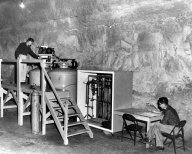
It was hot at the bottom of the mine. Here's Ray swimming in the water tank:
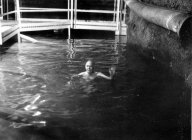
Three years ago some people at the Sudbury Neutrino Observatory showed that when neutrinos are flying out from the sun they most likely change from one type to another. This explains the shortage or neutrinos detected by Ray Davis.
http://physicsweb.org/article/world/14/7/10
The National Science Foundation is planning to build a neutrino lab in the U.S. They're currently evaluating several present and potential holes in the ground around the country, along with associated political contributions. They expect to build the lab in 2008.
http://wired.com/news/technology/0,1282,63102,00.html
Memorial Day
This is Memorial Day Weekend, when people are supposed to remember people who died in wars, and when people generally go to the lake or mountains or beach and have fun. I think it's possible to do both.Last April a lady named Tami took a picture of some military coffins on an airplane in Kuwait. These coffins were full of people who died in Iraq. She sent the picture to the Seattle Times in case they wanted to put it in the paper. They did. Tami didn't get paid for her picture. But she got fired Wednesday taking the picture.
http://seattletimes.nwsource.com/html/localnews/2001909527_coffin22m.html
There are military rules against taking pictures of the loaded coffins when they return from Iraq. Some people say it is disrespectful to show a bunch of coffins in the news. Some other people say the dead people should not be swept under the rug and forgotten. Some people say it's just to avoid bad war publicity. Some people say it would be wrong to use pictures of coffins for political purposes.
I think if I was inside one of those coffins I'd prefer to be on the news so people would be more likely to remember what I died for, or at least so my friends and relatives could laugh at me.
A guy named Russ used the Freedom of Information and managed to get some coffin pictures legally. The government has put a stop to it now. Here are the ones he got. They look pretty respectable to me.
http://www.thememoryhole.org/war/coffin_photos/dover/index.htm
About 800 U.S. and 900 coalition (including U.S.) soldiers have died in the Iraq war. The current rate is about 2 people per day. A little over 4,000 people have been wounded.
http://206.51.224.187/icasualties/bar.aspx
About 58,000 U.S. people died in Vietnam over 14 years.
Here's a week's worth of news on the Iraq war. Some of it is slanted against the war and against the U.S., and some of it comes directly from the U.S. Department of Defense. I was surprised how many articles there are about the Iraq war that I never see.
http://xpda.com/junkmail/junk157/weekiniraq.htm
Here's where to find the current Iraq war news:
http://lunaville.org/warcasualties/Summary.aspx
Donald Knuth Lectures Online!
These are good.http://scpd.stanford.edu/scpd/students/Dam_ui/pages/ArchivedVideoList56K.asp?Include=musings
American Small Business Computers
Check out our catalog, 20+ years old. RAM is 7,500 times cheaper today.http://xpda.com/asbc
Live from Mars!
Here is a good panorama of the Endurance Crater on Mars, taken by the Rover Opportunity. (This is a 1.1 meg image.)The Endurance Crater is an impact crater that's about 130 meters in diameter. This means something fell from the Martian sky once that knocked a hole in the ground that size. It's fairly small, as far as Martian craters go. The Gusev Crater where the Rover Spirit landed is about 160 km wide.
The colors in this picture are taken from three relatively narrow bands, filters L2, L5, and L6 in the panoramic camera. This means they used near infrared for red, yellow-green for green, and blue for blue. Then it was doctored up a little bit.
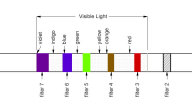
You can see that only small percentage of the visible color spectrum (filters 5 and 6 in this illustration) was used to make up the color in the panorama. When you visit Mars it may look a little different. I expect NASA used only three filters to save time, power, and bandwidth. The landscape image is made up of 258 individual images taken over two days. Here's the hi-resolution version.
Prisoners and Interrogation
It's interesting to read about all hoopla surrounding the U.S. and British prisoner abuse in Iraq and elsewhere. The abuse is wrong, but on the most part it's much better than that dished out by Saddam Hussein's government, the Syrian government, or the Taliban, where people were liable to have their fingernails yanked, their tongue cut out, or worse.One thing I find interesting is that most public people, the press and opposition parties included, were willing to ignore it all until they were confronted by photos and videos.
There have been lots of times in the past 3 years when the U.S. captured a high-ranking enemy of one variety or another and reported that they got a lot of valuable information from that individual. Do people think that high-ranking enemies are going to talk whenever they're captured just because they're not one of the "good guys?" I suspect that the vast majority require a certain amount of "physical and mental coercion."
Another fact that's been glossed over is that the U.S. government says rights under both the Geneva Convention and the U.S. Constitution do not apply to prisoners in Guantanamo. That may or may not be right, but why would the government make that claim unless they intended to break those rules? It seems kind of obvious.
Another fact that has been reported and largely ignored is the that people are captured, abducted, detained, seized, or whatever the going term is, by the U.S. from the U.S. or overseas, and placed in a foreign jail under the authority of Syria, Afghanistan, or another country that doesn't have the stellar human rights record of the United States. Those people end up undergoing quite a lot of "physical and mental coercion."
http://www.washingtonpost.com/ac2/wp-dyn?pagename=article&contentId=A522-2003Nov4
Yet another consideration is the fact that the CIA uses private contractors for interrogation. These contractors are not legally bound to follow same rules as the CIA. Why are they necessary, if not to bend the rules?
http://www.msnbc.msn.com/id/4964993/
Some of the interrogators are from the Department of the Interior. Why? Maybe it's because they are not liable for overseas crimes like the CIA and the military.
http://www.baltimoresun.com/news/nationworld/iraq/bal-te.contractor24may24,0,1298454.story
I think that whatever is going on in prisons, prison camps, interrogation centers, and detention centers will be eventually made public. Prisoners, guards, and other witnesses will eventually feel free to talk after they've been away from the prison or military environment for a while. I also think that a lot of the low-level people involved in meting out "physical and mental coercion" are going to be surprised at the lack of support from their superiors when the fireworks start.
Similar abuse has probably gone on in most wars, but "things are different now." No, it's not terrorism. Terrorism has been around for thousands of years. It's efficient, instant, worldwide communications that have made things different.
Here's a long article with more details than I've seen about the interrogation scandal. It seems pretty accurate. Whether you agree or disagree, it's worth reading.
http://www.newyorker.com/fact/content/?040524fa_fact
Here's another article.
http://msnbc.msn.com/id/4989481/
747 Tanker
Here's a picture of a supertanker: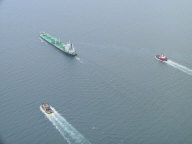
Here's another one:
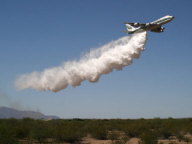
Evergreen Aviation has a Boeing-747 used to drop water, fire retardant, and various and other sundry chemicals on forest fires and other targets. The plane is being tested now. In March and April the plane completed 82 drops from 400-800 feet, and a bunch of dry runs. They plan to have it ready for service by July. It carries 7 times more than the largest firefighting tanker currently in service.
http://www.evergreenaviation.com/supertanker/gallery.html
http://www.evergreenaviation.com/supertanker/faq.html
The Evergreen web site mentioned that the tanker could be useful for Homeland Security. I would guess that it could be used to drop just about any chemical (that's not too corrosive) anywhere. Chemicals can be expelled out of the nozzles under pressure, so that should keep most of the bad stuff off the plane. The 747 tanker even has FLIR for low night flying.
I assumed that Evergreen Aviation was a branch of the Evergreen Group out of Taiwan. I was wrong. Evergreen Aviation is a private company that flies air cargo and stuff like that. They've got a history with the CIA. I believe Evergreen bought most of CIA's Air America assets when congress shut it down. There were some accusations of shady deals involved in that. Evergreen has done some CIA contract work, but I don't think that's the majority of their business.
http://seattlepi.nwsource.com/archives/1993/9310250073.asp
http://www.columbusalive.com/2001/20010809/080901/08090108.html
B-52 RC Model
On May 8 at Merryfield, Somerset, U.K., Gordon Nichols flew is model airplane. His model is a scale model of a B-52, complete with eight jet engines. It weighs 300 lbs. Here's the plane: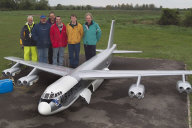
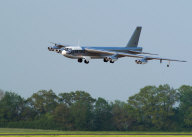
Here's a video of the takeoff:
http://xpda.com/junkmail/junk157/B52-008.wmv
Here are the engines on a test stand:
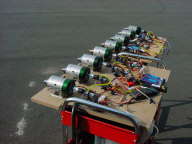
The engines are made by Wren:
http://www.wren-turbines.com/news.htm
Flying Wing
Here's an interesting article about the early flying wing airplanes.http://www.pilotfriend.com/century-of-flight/Aviation history/jet age/Northrop wing1.htm
Computer Fan Noise
Is your computer too loud? Try active noise canceling. That amounts to taking a microphone listening for noise sound waves, and producing the opposite wave to cancel out the sound. They do it in aviation and other headphones.A guy at Brigham Young University and some grad students built an active noise cancellation system for PCs. It uses four speakers and works pretty well.
http://byunews.byu.edu/release.aspx?story=archive04/May/activenoisecontrol
Here's what it looks like:
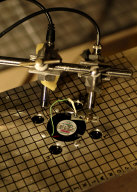
Mozilla
I've given up Internet Explorer! I tried out the latest Mozilla, since it has a cool name, and decided that I like it better. It works with all the web sites I've tried, and does a lot of things better then IE. There's a new version of Netscape coming out that is based on this version of Mozilla, which is 1.7.http://zdnet.com.com/2100-1104_2-5221982.html
Mozilla has a built-in popup stopper that works better than the 3rd party ones I've tried for Internet Explorer, and there are a bunch of free add-ons you can use with Mozilla. The important ones for me are AdBlock and FlashBlock.
AdBlock lets you block advertisement images from coming up on web pages. All you do is right-click on an ad, optionally change it's URL to a wildcard, and from then on it's blocked. For example, you can remove everything containing "doubleclick" or "/ads/".
FlashBlock puts a play butting in the place of all flash animations on a page. Then if you want to see it, you can click on the Play. This gets rid of most video ads.
Now I can go to places like cnn.com or usatoday.com and not be annoyed by stupid ads. Pages also load faster. Doonesbury loads 30%-50% faster (it varies) with Mozilla/AdBlock/FlashBlock than with Internet Explorer, using a modem. I haven't taken the time to see what exactly is not being downloaded, but it does make a difference.
SpamBayes
Thomas Bayes lived from 1701 to 1761. He made a mathematical rule. The rule says essentially that probability changes based on additional input. Here is some more info:http://www.ai.mit.edu/~murphyk/Bayes/economist.html
Bayes' rule was passed on after his death to an heir, and wasn't noticed much until LaPlace came up with the same thing independently a few years later. Bayes would undoubtedly be thrilled to know that he got his name on a spam filter, especially since LaPlace got his own equation, transform, series, distribution and a bunch of other stuff.
Bayes' rule is commonly used in spam filtering now. You can train your own spam filter based on which of your emails are legit and which are spam. The filter takes the new data into account when it's deciding whether to flag an email as spam. Here's a good article on various spam-killing methods:
http://www.paulgraham.com/stopspam.html
We have used Bayesian filters at upperspace.net and upperspace.com, but they got too many false positives. There are probably two reasons for this. First, Bayesian filtering doesn't work as well at the mail server because different people have different spam and different legitimate email. What works for me might flag spam incorrectly for someone else. Second, we didn't do a very good job of training our Bayesian filter. So we turned off the Bayesian filter and started bouncing email that is blacklisted at spamcop.net. This seems to get about 75% of the spam.
Here's a free Bayesian filter, SpamBayes, that works with most email client software. I've been using it for a few days and it works really well.
http://spambayes.sourceforge.net
Quotes
"Support for Saddam, including within his military organization, will collapse at the first whiff of gunpowder."Richard Perle, advisor to Donald Rumsfeld, 2002
"I would be the first to acknowledge we allowed the liberation (of Iraq) to subside into an occupation. And I think that was a grave error, and in some ways a continuing error."
Richard Perle, advisor to Donald Rumsfeld, May 2004
http://www.thestar.com/NASApp/cs/ContentServer?pagename=thestar/Layout/Article_Type1&c=Article&cid=1085523609417
"There are some who feel like that, you know, the conditions are such that they can attack us there. My answer is bring them on. We got the force necessary to deal with the security situation."
George W. Bush, July 2, 2003, on Iraq
(This is the USAToday translation. Whitehouse.gov cleaned it up a little.)
http://www.whitehouse.gov/news/releases/2003/07/20030702-3.html
http://www.usatoday.com/news/washington/2003-07-02-bush-speech-text_x.htm
Bridge Building, etc.
The tallest bridge in the world is now in southern France. Its tallest pillar is 340 meters high, and the road is 245 meters off the ground.http://news.bbc.co.uk/2/hi/europe/3759307.stm
In July 1, 2000, the Oresund Bridge from Copenhagen, Denmark to Sweden opened for traffic
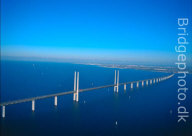
http://news.bbc.co.uk/2/hi/europe/800447.stm
The Akashi Kaikyo bridge, completed in 1998 near Kobe, Japan, has the longest span in the world.
http://www.pbs.org/wgbh/buildingbig/wonder/structure/akashi_kaikyo.html
Last year China started construction on the world's longest trans-oceanic bridge, across Hangzhou Bay.
http://english.peopledaily.com.cn/200306/08/eng20030608_117842.shtml
Last September, the tallest building in the world was completed in Taiwan.
http://news.bbc.co.uk/1/hi/world/asia-pacific/3200160.stm
This building in Shanghai, China should be taller in 2007:
http://www.mori.co.jp/forest/world/top-e.html
http://www.kpf.com/Projects/mori.htm
The new World Trade Center in New York might eventually be taller than that.
Grad School
Over the past year there has been a 32% drop in international graduate school applications to U.S. Universities, according to the Wall Street Journal (May 13). This takes away a significant source of money for universities.The primary reason for the drop is that students from other countries don't know whether they'll be allowed into the U.S. when it's time to go to college. Delayed visa applications are common, and the average waiting time for a delayed visa is now 4.5 months. Once they're in the U.S., many international students are afraid to visit home because they might not be allowed back into the U.S.
The Department of Homeland Security is aware of the problem. DHS boss Tom said, "Graduate students are inherently evil. Not only do we plan to stop international grad students at the border, we have a program underway to deport all U.S. grad students to Tasmania."
Here's the article, but it requires a subscription:
http://online.wsj.com/article/0,,SB108440195338910027,00.html
Regarding John Ashcroft's announcement of impending terrorist attacks this summer, Tom said, "That's a bunch of garbage. Ashcroft thinks he'll be able to run for President in 2008 by hyping terrorism in 2004. That's my job, and I'll be danged if I raise the threat level when he beats me to the punch."
http://www.msnbc.msn.com/id/5087301/
Cross-Country Wireless
If you happen to be wandering around the country this summer and would like to find some wireless internet access, it may be easier than you think. This site lists thousands of public hot spots, some free and some for about $10 a day.http://www.jiwire.com
Pictures of Today!
A true-color image of contrails over northwest Europe, April 25, 2004: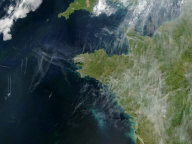
An infrared photo of contrails in the southeast U.S., taken January 29, 2004 by the Terra satellite:
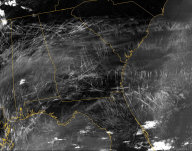
Mount St. Helens, from the Space Station, October 25, 2002 using a Kodak DCS760 digital camera with an 800 mm lens:
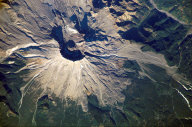
Saturn on March 27, 2004, by Cassini. Moons visible in this image are (clockwise from top right): Enceladus (310 miles across), Mimas (247 miles across), Tethys (659 miles across) and Epimetheus (72 miles across). Epimetheus is dim and appears just above the left edge of the rings.
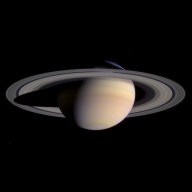
The Ring Galaxy AM 0644-741, by Hubble Space Telescope, January 2004.
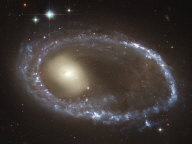
Gusev Crater, by the European Mars Express. The Spirit rover landed in the dark area in the center of this picture. The image is about 60 km wide at the bottom, and is oriented so north is up.

Capitol Reef, Utah
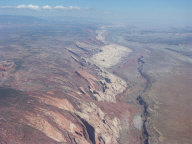
Big Clouds over Arkansas:
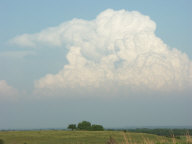
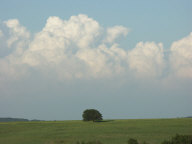
A wild animal:
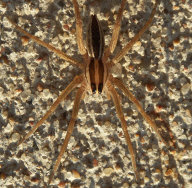
(c) 2048, no rights reserved. Copy the heck out of this thing!
Want to sign up? Want to read more?
http://xpda.com/junkmail
Want to stop getting this fine piece of tripe? Please select one or more of the following easy-to-use options:
a. Change your email address and don't tell anybody.
b. Give up on digital computing and go analog.
c. Provide expert assistance to Al Kider and then call Attorney General John a wimp.
d. Send me an email with "Kangerlussuaq" as the subject.
I'm Bob Webster from Pryor. I can usually be reached at bob@xpda.com
Have a nice day!